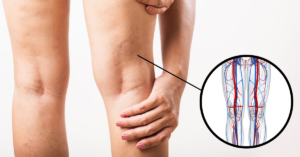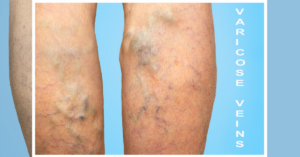If you’ve been experiencing unexplained swelling, pain, or a sluggish feeling in your lower limbs, it might be time to take a closer look at the function of your blood vessels – specifically your arteries and veins.
The circulatory system is a crucial component of our bodies, responsible for delivering oxygen and nutrients to our organs and tissues while simultaneously removing waste products. Without this complex network of arteries, veins, and capillaries, our bodies simply wouldn’t be able to function effectively. And while it’s easy to take the circulatory system for granted, it really does affect our overall health in a multitude of ways.

But when the circulatory system is compromised, either through poor lifestyle choices or disease, it can lead to a variety of serious health issues, including pain, swelling, or numbness in the legs and feet.
At ECCO Medical in Lone Tree, Colorado, our qualified team of interventional radiology specialists have ample experience treating leg pain that stems from arterial or venous issues – and we can do the same for you!
In this blog post, we’ll discuss the difference between arterial-based issues versus venous issues that affect your legs and feet. Plus, we’ll explore the available treatment options for each so that you can get back on the path toward pain-free movement.
Understanding the Arterial System
As one of the primary components of the circulatory system, arteries are blood vessels that are responsible for carrying oxygenated blood away from the heart to various tissues and organs throughout the body. These vessels are thick-walled, elastic, and muscular, which enables them to stretch and contract with each heartbeat and regulate blood pressure.
In addition to their primary function of delivering oxygenated blood, arteries also play a crucial role in maintaining healthy vital organs, tissues, and muscles by supplying critical nutrients and proteins to these body parts.
The muscular middle layer of arteries is what sets them apart from veins, which have thinner walls and less smooth muscle. The smooth muscle allows arteries to dilate and constrict in response to signals from the nervous system, which is crucial for regulating blood pressure and flow.
However, despite the essential role of arteries in maintaining overall body health, they can be prone to various issues that can cause severe problems, such as Atherosclerosis, arterial plaque buildup, and Peripheral Artery Disease (which is perhaps the most common).
Atherosclerosis
Atherosclerosis is a condition in which plaque composed of cholesterol, fat, and other substances accumulate on the walls of arteries, causing them to become narrower and reducing the flow of blood throughout the body. As a result, patients with atherosclerosis may experience symptoms such as chest pain, shortness of breath, fatigue, and dizziness.
Diagnosis of atherosclerosis is typically through tests such as CT scans, MRIs, or angiograms. Treatment options may range from lifestyle changes such as diet and exercise to medication and, in extreme cases, surgery.
Arterial Plaque Buildup
Arterial plaque buildup occurs when fatty deposits accumulate on the walls of arteries, which can lead to the hardening and narrowing of blood vessels and, eventually, blockage of blood flow. This condition can restrict blood flow to critical organs and tissues, leading to various health issues.

Peripheral Artery Disease
Peripheral artery disease, on the other hand, occurs when the arteries in the legs, arms, or pelvis become narrowed and limit blood supply to these regions. Patients with peripheral artery disease may experience symptoms such as:
- Pain, numbness, or heaviness in your legs, especially when walking or climbing stairs
- Burning pain in the toes and feet when at rest or that disturbs your sleep
- Sores or wounds on your legs, feet, and toes that fail to heal
- Color changes in your feet that turn the skin pale or blue
- Poor nail growth and/or decreased hair growth on legs and toes
- In men, erectile dysfunction, especially if you also have diabetes
To diagnose conditions such as plaque buildup and peripheral artery disease, doctors may order a variety of tests, including ultrasounds and CT scans. Treatment options may range from medication and lifestyle changes, such as smoking cessation and exercise, to a selection of minimally invasive procedures, such as angioplasty or atherectomy.
“He (Dr. Kovaleski) explained to me that basically I had clogged arteries in both legs to the point where I didn’t have circulation going to my toes… but he (Dr. Kovelaski) says each time ‘we’re going to get you back up walking… we’re going to get you back up dancing.’ – and I got to dance!” – Dianne Gum
It’s crucial to maintain a healthy lifestyle to prevent arterial problems. Simple changes such as eating a nutritious diet and exercising regularly can significantly reduce the risk of developing these issues. Managing underlying health conditions such as high cholesterol, diabetes, and high blood pressure can also help prevent arterial problems.
Understanding the Venous System
Veins are an essential part of our circulatory system, responsible for carrying deoxygenated blood from different parts of the body back to the heart. Unlike arteries, veins have thinner walls and are equipped with valves that prevent the backflow of blood.
Apart from their primary function, veins also play an important role in regulating blood pressure and maintaining body temperature. They are also responsible for removing waste and toxins from the body.
Despite their crucial role in our body, veins can sometimes become compromised due to various factors. One of the most common venous issues is varicose veins.
Varicose Veins
Varicose veins are swollen and twisted veins that usually occur in the legs. They are often caused by weakened vein walls, faulty valves, or increased pressure in the veins. Symptoms of varicose veins include:
- Throbbing pain
- Swelling
- Cramping
Diagnosis is usually done through a physical exam, but imaging tests such as ultrasound may also be helpful. Treatment options include compression stockings, lifestyle changes, and minimally invasive procedures such as sclerotherapy or endovenous laser treatment.
“In May of 2020, I had a Varicose vein procedure to relieve pain in my lower legs. After extensive research, I was lucky enough to have found Dr. Kovaleski. Today, I’m happy to report I’m pain-free and the unsightly veins are gone! Thank you, Dr. Kovaleski and staff. “ – Brad R.

Deep Vein Thrombosis
Another venous issue is Deep Vein Thrombosis (DVT). This occurs when a blood clot forms in one or more of the deep veins in the body, usually in the legs. While only 50% of DVT patients experience actual symptoms, those may include:
- Swelling in your foot, ankle, or leg, usually on one side
- Cramping pain in your affected leg that usually begins in your calf
- Severe, unexplained pain in your foot and ankle
- An area of skin that feels warmer than the skin on the surrounding areas
- Skin over the affected area turning pale or a reddish or bluish color
A diagnosis is made through imaging tests, such as an ultrasound, and can be managed at ECCO Medical either with Pharmacologic Management or a Venogram with Intervention.
Chronic Venous Insufficiency
Chronic Venous Insufficiency (CVI) is another common venous issue. It occurs when the superficical veins in the legs are unable to transport blood back to the heart. Symptoms can include:
- Varicose Veins
- Leg Swelling that gets worse throughout the day
- Leg Pain that gets worse throughout the day
- Slow Healing Wounds in your legs
- Muscle Cramping in legs
- Skin Discoloration of the lower legs
Diagnosis is usually done through a physical exam and imaging tests. Treatment options available at ECCO Medical for this condition include Vein Ablations, Phlebectomy, and Foam Sclerotherapy.
While these venous issues can cause discomfort and pain, they can often be prevented or minimized by making some lifestyle changes. Regular exercise is an essential habit to prevent these issues from arising or getting worse. Even simple exercises, such as walking or stretching, can help improve blood flow in the veins. Avoiding prolonged standing or sitting is also important, as it can increase pressure on the veins and hinder blood flow.
Conclusion
When it comes to the circulatory system, the arteries and veins are crucial components that ensure everything runs smoothly. Any issues with these vessels can lead to discomfort, pain, and even serious health problems. That’s why it’s important to take care of them and seek help when needed.
At ECCO Medical, we understand the complexities of arterial and venous issues and can provide a comprehensive evaluation to help determine the best course of action. Our goal is to create a personalized treatment plan that meets your unique needs so that you can get back to pain-free movement and optimal health.
Don’t let circulatory issues hold you back – contact us today and start your journey to a better quality of life!




